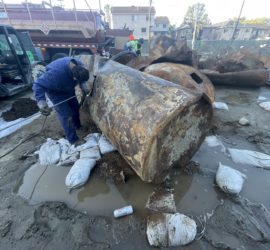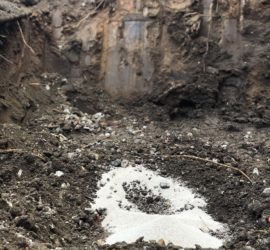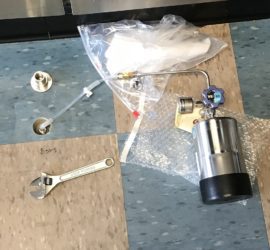C8 Test for Soil Contamination & Pollution
Performing a C8 test for the presence of PFOA, PFOS, and other PFAS or next-generation substances helps verify the possibility of soil contamination and drinking water pollution. At a minimum, C8 testing includes PFOA and PFOS as testing parameters, which are ubiquitous pollutants and emerging chemicals of concern. Upon introduction into the environment, C8 often ends up inside the bodies of people, where it can remain in the bloodstream for many years. In fact, scientists can perform C8 testing in the body, as well as in soil and water. But where does the chemical contamination journey begin? In many cases, it starts with an introduction to the soil. There are multiple pathways, including surface water, landfills, wastewater, air, and direct disposal of C8 products to the ground surface. Updated April 18, 2024.
C8 Test of Surface Water & More
In performing a C8 test, scientists must consider the fate and transport of the contaminant. For instance, a common receptacle for C8 waste is nearby surface water systems. Historically, fluids containing C8 discharge from industrial facilities, directly into nearby water sources such as lakes, rivers, streams, and swamps. Other times, the industrial wastewater is sent to a water treatment facility, where the C8 can still persist through the treatment process, and still end up in surface waters. And soil is the media that catches contaminants, underneath and around these surface water sources. Consequently, C8 easily transports from water, into the surrounding soil. Each of these media can undergo C8 testing. However, when determining sample locations and quantities, environmental professionals must also consider the transport characteristics of the pollutant.
Biosolids
Another way C8 can enter the soil is through the direct application of biosolids, also known as sewer sludge. This solid matter contains all the non-liquid material that is removable during the wastewater treatment process. These biosolids can contain high amounts of C8, especially if the water treatment plant is accepting wastewater from relatable manufacturing facilities. The biosolids contain all the organic and inorganic compounds which undergo extraction during treatment. And in some cases, biosolids re-apply as an agricultural fertilizer after extraction from the wastewater. If the contamination within biosolids is spread onto the soil, the C8 substances leach into the deeper soil horizons as well. Other options for disposing of biosolids include disposal into a landfill or burning in a sewer sludge incinerator. Biosolids, as well as the soils they dump on, are common media for a C8 test.
Atmosphere
When C8 waste is incinerated at a manufacturing or waste-disposal facility, the resulting smoke contains high levels of contamination. Consequently, C8 enters the atmosphere this way, where it may remain suspended for some time before eventually settling back down onto the ground surface. Wherever it may land, is where it further transports through the environment. In this way, the C8 reaches and contaminates soils that can be vast distances from the initial point of release. As a result, this substance is also detectible in rainwater, which serves as another vehicle to transport. Accordingly, surrounding surficial soils, surficial water systems, and rainwater runoff can all undergo C8 testing.
C8 Testing Around Landfills
Another way PFAS substances enter the subsurface is through landfills. Anything put in a landfill has the potential to contaminate the surrounding and underlying soil and groundwater. Thus, hazardous waste such as this must undergo proper handling and special treatment in order to reduce environmental risk. But it’s not only the landfilling of industrial waste from manufacturers that poses a risk to the environment. It’s also the disposal of the products and consumer goods after dumping. For instance, pots and pans with non-stick surfaces decaying underground. Eventually, all breakdown products can migrate within a landfill, and have the potential to contaminate the subsurface. As a result, environmental professionals can conduct a C8 test of the subsurface materials at and around a landfill facility, to determine the lateral and vertical extent of the contamination.
Fires at a Landfill
Furthermore, as a result of high methane soil gas concentrations at landfill facilities, combustion occasionally occurs, resulting in a fire. Consequently, fires at such facilities can accelerate the breakdown and leaching process of PFAS chemicals within buried products. Additionally, when there is a fire at a landfill, the foam that firefighters use to put out the flames is often a C8-containing product with the name “Aqueous Film-Forming Foam,” or AFFF. Whether from fires or leaching, C8 testing aims to determine the levels of pollution that migrate outside of landfills, and their extent of influence.
AFFF (Fire-Fighting Foams)
AFFF stands for “Aqueous Film-Forming Foam.” This firefighting tool has long been an effective solution for putting out fuel fires. The problem is that AFFF contains both PFOA and PFOS. During its application, firefighters tend to spray massive quantities directly onto the burning substance, as well as the ground. As a result, this product is a major contributor to C8 contamination in soil and groundwater. Consequently, C8 testing may be warranted in areas of prior significant burns.
The use of this foam, and subsequent C8 pollution, often centers around civilian and military airfields. This is because of the large amounts of jet fuel stored at airports, and the need to prevent and combat jet fuel fires. AFFF is often sprayed as a precautionary measure when fuel is spilled, and it is sometimes accidentally sprayed or released unintentionally. Furthermore, firefighter training programs tend to use this C8 foam a lot and accordingly spray it directly into the environment. These examples of its widespread use clearly show why AFFF is a major contributor to PFAS contamination in soil and groundwater. As a result, a C8 test of soil underlying military airfields, airports, refineries and fueling facilities may indicate high levels of PFOA and PFOS.
Authors:
Written By: Michael Joseph Sabo
Edited By: Adam Azad Kaligi, PG
Sources:
U.S. Department of Defense
U.S. Environmental Protection Agency
https://www.epa.gov/biosolids/land-application-sewage-sludge



